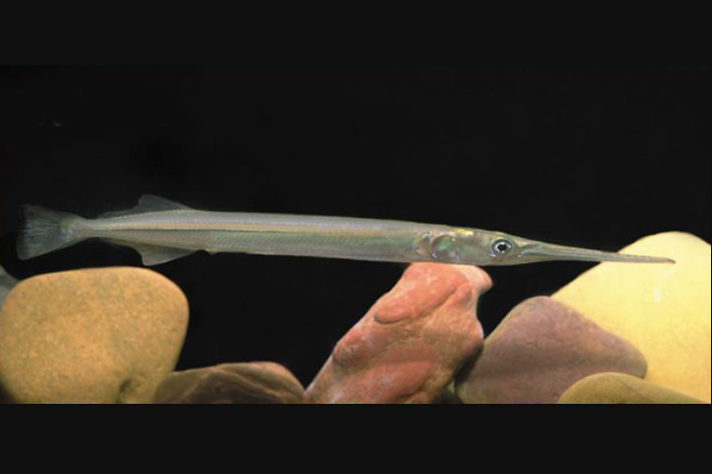Freshwater Longtom, Strongylura krefftii (Günther 1866)

Freshwater Longtom, Strongylura krefftii, from the Fitzroy River, Kimberley, Western Australia. Source: David Morgan / Freshwater Fish Group & Fish Health Unit, Murdoch University. License: All rights reserved
Freshwater Longtom, Strongylura krefftii (Günther 1866)
More Info
|
Distribution |
Found in coastal rivers of tropical Australia and New Guinea. In Australian waters, the Freshwater Longtom is known from the Fitzroy River, WA (17º45´S) to the Dawson River, QLD (24º33´S). Although a number of authors have recorded this species from northern NSW, there are no reliable records could be found. The Freshwater Longtom lives in still or flowing water of larger rivers from tidal reaches to well inland, with adults sometimes found in coastal marine waters. Habitats include main river channels, floodplain lagoons, muddy creeks, escarpment streams, lagoons and billabongs; often shelters amongst overhanging vegetation or submerged roots. The species has a wide temperature tolerance in northern Australia, from about 23-38°C. |
|
Features |
Dorsal fin 16-18; Anal fin 19-21; Pectoral fin 11-12; Pelvic fin 6. |
|
Size |
To 85 cm SL, commonly 30-40 cm. |
|
Colour |
Silvery to olive green overall often with a blue tinge ventrally; fins translucent to yellowish or slightly dusky. |
|
Feeding |
Feed at night in shallow water mainly preying on small fishes, as well as crustaceans and surface-dwelling insects. Adults feed almost entirely on fishes. Reportedly launches ambush attacks on smaller fishes form the cover of overhanging vegetation. |
|
Biology |
Little is known of the breeding biology of this species however spawning is thought to occur in freshwater between September and December. Females lay small eggs, 2 mm diam., presumably with adhesive filaments that attach to aquatic plants. Larvae presumably pelagic. |
|
Fisheries |
The Freshwater Longtom will take a lure and may also attack smaller fishes that have been caught on hook and line. The Longtom is reportedly a good-eating fish, although very bony. |
|
Species Citation |
Belone krefftii Günther, 1866, Cat. Fishes Brit. Mus. 6: 250. Type locality: Australia (="Sydney, N.S.W"). |
|
Author |
Gomon, M.F. & D.J. Bray. 2010 |
Freshwater Longtom, Strongylura krefftii (Günther 1866)
References
Allen, G.R. 1982. Inland Fishes of Western Australia. Perth : Western Australian Museum 86 pp.
Allen, G.R. 1989. Freshwater Fishes of Australia. Neptune, New Jersey : T.F.H. Publications pp. 1–240
Allen, G.R., Midgley, S.H. & Allen, M. 2002. Field guide to the freshwater fishes of Australia. Perth : Western Australian Museum 394 pp. [125].
Grant, E.M. 1975. Guide to Fishes. Brisbane : Co-ordinator-General Department 3rd Edn 640 pp. [105] (as Stenocaulus kreffti)
Larson, H.K. & Martin, K.C. 1990. Freshwater Fishes of the Northern Territory. Northern Territory Museum of Arts and Sciences Handbook Series Number 1. Darwin : Northern Territory Museum of Arts and Sciences 102 pp.
Merrick, J.R. & Schmida, G.E. 1984. Australian Freshwater Fishes Biology and Management. Sydney : J.R. Merrick 409 pp.
Morgan, D.L., M.G. Allen, P. Bedford & M. Horstman. 2004. Fish fauna of the Fitzroy River in the Kimberley region of Western Australia – including the Bunuba, Gooniyandi, Ngarinyin, Nyikina and Walmajarri Aboriginal names. Records of the Western Australian Museum 22: 147–161.
Pusey, B.J, Kennard, M.J. & A.H. Arthington. 2004. Freshwater Fishes of North-Eastern Australia. CSIRO Publishing, Collingwood, Victoria.
Pusey, B.J, Kennard, M.J. & Bird, J. 2000. Fishes of the dune fields of Cape Flattery, northern Queensland and other dune systems in north-eastern Australia. Ichthyol. Explor. Freshw. 11(1): 65–74.


